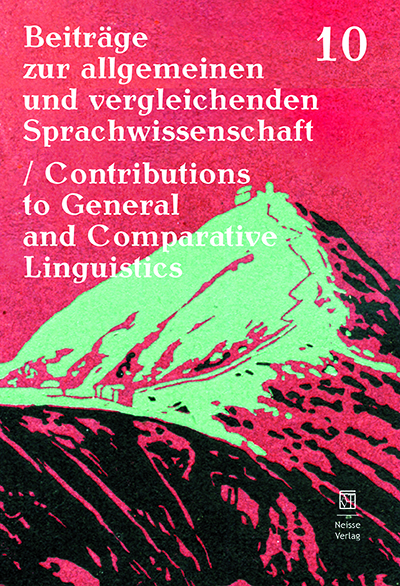
Beiträge zur allgemeinen und vergleichenden Sprachwissenschaft / Contributions to General and Comparative Linguistics
Numer 10 (2021): Varia et miscellanea
Redakcja: Edyta Błachut, Adam Gołębiowski, Dorota Klimek-Jankowska, Krzysztof Migdalski
A cognitive and corpus-based study of the connotative potential of the adjectives czerwony ‘red’ and czarny ‘black’ in modern Polish political discourse
DOI: 10.23817/bzspr.10-1 (data publikacji online: 2021-12-01)
s. 7–20
Słowa kluczowe: red, black, metaphor, metonymy, discourse
The paper discusses metaphorical and metonymic extensions of the adjectives czerwony ‘red’ and czarny ‘black’. The connotative potential of red and black colour collocations is analyzed and discussed. Red and black collocations were excerpted from the two largest corpora, i.e. NKJP and MoncoPL. All colour citations are analysed in the framework of discourse analysis and conceptual metaphor and metonymy. The analysis indicates that extralinguistic factors (i.e. social, political and historical events) motivate the emergence of red and black colour collocations in modern Polish discourse.
The influence of segmental errors and stress-placement errors on Polish listeners’ perceived degree of foreignaccentedness in non-native speech
DOI: 10.23817/bzspr.10-2 (data publikacji online: 2021-12-01)
s. 21–42
Słowa kluczowe: foreign accent perception, stress-deafness, non-native speech
Polish listeners’ perception of different types of errors in non-native speech was studied with a focus on segmental and stress-placement errors. The stimuli consisted of the speech produced by Polish learners of Russian, Czech, and Spanish origins. The results which were obtained suggest that segmental errors (i.e., errors related to the pronunciation of segments) influence the foreignaccentedness perceived by Polish listeners significantly more than stress-placement errors. That is probably due to stress-deafness experienced by native speakers of Polish. While stress-placement errors resulted in relatively low scores in terms of foreignaccentedness, the ratings for segmental errors depended on the L1 group of the speakers. Segmental errors produced by speakers of Spanish were rated as the most foreign-sounding, followed by Czech and Russian. One possible explanation is that it was caused by the sound systems of Russian, Czech, and Polish being pretty similar, while the Spanish sound system is somewhat different.
Einige Bemerkungen zum partitiven Genitiv im heutigen Polnisch und zu seinen deutschsprachigen Äquivalenten / Some Reflections on Partitive Genitive in Contemporary Polish and its Equivalents in German
DOI: 10.23817/bzspr.10-3 (data publikacji online: 2021-12-01)
s. 43–69
Słowa kluczowe: category of grammatical case, partitive genitive, accusative, syntax, Polish-German contrastive studies
The topic of this paper is so-called Partitive Genitive (PG) as a verbal compliment, which is one oft the most characteristic syntactic constructions of the Polish language and of the others Slavic languages. PG is typical of spoken language and compatibel only with restricted class of perfective verbs. Different frames and a short characteristic of the subject in the Polish linguistic literature were presented. Reflections in the main part of the article are limited to a selected morphological, syntactic and semantic phenomenon of PG with perfective and imperfective verbs. The possible equivalents of Polish PG in German were also presented.
Grammatical aspect in Polish and the perception of event duration
DOI: 10.23817/bzspr.10-4 (data publikacji online: 2021-12-01)
s. 71–96
Słowa kluczowe: Polish grammatical aspect, event duration, semantics
Earlier research showed that the progressive aspect in Dutch extends duration estimations for short events and shortens the perception of inherently medium and long events. In the study reported here, we conducted an experiment examining whether the same effect can be observed in Polish, a language with a morphologically realised perfective vs. imperfective distinction. We confronted two views on grammatical aspect. The first one postulates that English simple past tense verbs of telic predicates introduce a silent PERF operator and that the Polish imperfective is equivalent to the English progressive. According to the second view, there is no PERF operator in simple past clauses in Dutch (and by analogy also in English), while perfective eventualities in Polish should be perceived as shorter than imperfective events which view the event from the inside without imposing any boundaries on its runtime. The results of this study show that the second view is more plausible, suggesting that languages vary in the interpretation of event duration depending on whether they have a clear grammatical aspect or whether such distinctions are less articulated.
Pilotstudie zu prosodischen Strategien in frei gesprochenen Konferenzvorträgen deutscher Linguisten / Pilot study on prosodic strategies in freely spoken conference lectures by German linguists
DOI: 10.23817/bzspr.10-5 (data publikacji online: 2021-12-01)
s. 97–117
Słowa kluczowe: prosodic strategies, conference lectures, scientific discourse
In this article, partial results of an empirical pilot study on prosodic strategies are presented in freely spoken conference presentations by German linguists. The study aims to take a closer look at the coexistence of prosodic and pragmatic phenomena in scientific discourse and to document the first observations on the speaking behavior of scientists in the field of prosody. The subject of investigation is three selected expert lectures, which were recorded as part of the GeWiss project at international conferences in Germany. The basis of the investigation is the auditory analysis carried out by the author, which is additionally supplemented by acoustic information in Praat.
Mechanismen und Tendenzen der kreativen Anpassung von IAW-Strukturen im Deutschen und im Französischen / Mechanisms and tendencies in the creative adaptation of IAW structures in German and French
DOI: 10.23817/bzspr.10-6 (data publikacji online: 2021-12-01)
s. 119–148
Słowa kluczowe: IAW structures, German, French, variation, creativity
German has a particularly large inventory of IAW structures, i.e. expressions such as zum Teufel ‘the devil’ and zur Hölle ‘the hell’ that are used as intensifiers in wh-questions. This is due to the fact that German maximally exploits the creative adaptation potential of IAW structures. French, on the other hand, has fewer IAW structures. However, as is shown in this paper, French has the same basic patterns according to which IAW structures are built and makes use of the same basic mechanisms for IAW modification that we also find in German, substitution and expansion. It thus seems that German simply makes more use of this adaptation potential that is also present in French. Still we also find some tendencies and restrictions in German, which also play a role in French. Two of them are discussed in more detail in this paper, viz. the preference for negatively connotated words and the role of the context and the community in which the IAW structures are used.
Pre-service teachers’ beliefs about teaching English to older adults: The case of motivation
DOI: 10.23817/bzspr.10-7 (data publikacji online: 2021-12-01)
s. 149–174
Słowa kluczowe: motivation, Foreign Language Geragogy (FLG), lifelong learning, the age factor, older adults, pre-service teachers’ beliefs
As of 2021, in Poland there are hardly any University courses preparing pre-service teachers to teach groups of the age of 60 and older. However, at the same time, it is estimated that in Poland older adults represent approximately 24% of the population and it is expected to increase to 40.4% by 2050. The number of private language centres and Universities of the Third Age (U3A) offering, among other subjects, foreign language education, is also constantly growing. In order to examine the value of introducing “Foreign Language Geragogy” (FLG, i.e. teaching foreign languages to older adults) to the curriculum, a qualitative study of forty two MA students from the Institute of English Studies (University of Wrocław) was carried out. Only half of the respondents attended the elective course and MA seminar “Older adults and SLA”, but both groups completed the same open-ended questionnaire, the aim of which was to explore pre-service teachers’ subjective theories regarding older adults’ motivation to learn foreign languages in later life, and to examine the extent to which they were affected by the content of the course. The results suggest that such courses are valuable, and pre-service teachers’ opinions regarding foreign language learning and teaching to older adults should be challenged in order to offer a better quality of teaching and to promote the idea of lifelong learning.
The functions of punning utterances in English and Chinese: a cross-cultural perspective
DOI: 10.23817/bzspr.10-8 (data publikacji online: 2021-12-01)
s. 175–199
Słowa kluczowe: puns, English, Chinese, language functions, high- and lowcontext, cultures
Capitalizing on the universal linguistic feature of ambiguity, punning utterances can be found in languages as distinct as the Indo-European, marginally inflected English and the Sino-Tibetan, monosyllabic, inflectionless Chinese. Though forming a tiny fraction of the utterances produced in these languages, they tend to stand out and can be encountered in diverse communicative settings, including poetry and prose, jokes and comedy routines, advertising slogans and book titles. Whether perceived as “the lowest form of wit” or a lofty rhetorical device, they perform a wide range of functions which are often grounded in distinct cultural and historical backgrounds they are embedded in. The objective of this article is to identify the most striking differences in the functions served by typical English and Chinese puns and to investigate the cultural factors underlying these differences. Adopting Jakobson’s model of language functions as the organizing principle for the discussion, I examine a range of puns in the two languages, comparing and contrasting the motivations for their use.
Intelligibility in the early language contact in Danelaw revisited
DOI: 10.23817/bzspr.10-9 (data publikacji online: 2021-12-01)
s. 201–221
Słowa kluczowe: Danelaw, mutual intelligibility, Proto-Germanic, comparative approach
The problem of intelligibility between Anglo-Saxons and Scandinavians in Danelaw has been a matter of dispute for over a century now. Two perspectives of looking at this issue have been proposed. One group of scholars claim that, due to a fair number of similarities in the lexis and grammar of the languages, the level of mutual intelligibility was high. The other party strongly objects to the view of commonalities and mutual comprehension. Instead, they argue for the idea of emerging bilingualism in Danelaw. This paper aims to adduce arguments to the claim of mutual intelligibility proposed by Townend (2002), among others. We provide an insightful etymological account of meticulously collected parallel words in the analysed languages. The search for the common ancestry of lexical roots is enhanced by the study of cultural context. Moreover, a comparative analysis of syntax, morphology, and pronunciation is also provided. The proposed complex analysis leads to the conclusion that the level of mutual intelligibility between the Old English speakers and Norsemen was high.
The Gothic Genitive Plural in /-ee/ Yet Again: A Sarmatian Solution
DOI: 10.23817/bzspr.10-10 (data publikacji online: 2021-12-01)
s. 223–247
Słowa kluczowe: Genitive case, Gothic, Iranian, Old Germanic, Sarmatian, Sarmatian influence on Gothic
Reasons are given to think that the Gothic GPL in /-ee/ (< /-ɛɛ/) developed in the M /n/-stems by analogy with GPL /-ↄↄnↄↄ/ in F /n/-stems: NSG /-ↄ/ : GPL /-ↄↄnↄↄ/ = NSG /-ɛ/ : GPL /-ɛɛnɛɛ/. This analogy was externally motivated, due to various features of Iranian causing Gothic F /-ↄↄnↄↄ/ and M /-ↄnↄↄ/ to both be rendered as /-aanaa/ in Sarmatian-accented Gothic. As levels of competence increased, /-aanaa/ was “genderized” (and “Gothicized”) by replacing gender-neutral /-aanaa-/ with F /-ↄↄnↄ/ (which spread to Pre-OHG) and M /-ɛɛnɛɛ/. Historical and lexical evidence is given indicating that Gothic culture and language were significantly influenced by their Sarmatian analogues, and additional cases where Gothic shows unusual grammatical resemblances to Iranian are adduced.
Institut für die Stärkung des Polnischen in Deutschland und Europa. Vorstellung eines besonderen Arbeitsfeldes
DOI: 10.23817/bzspr.10-11 (data publikacji online: 2021-12-01)
s. 249–251

